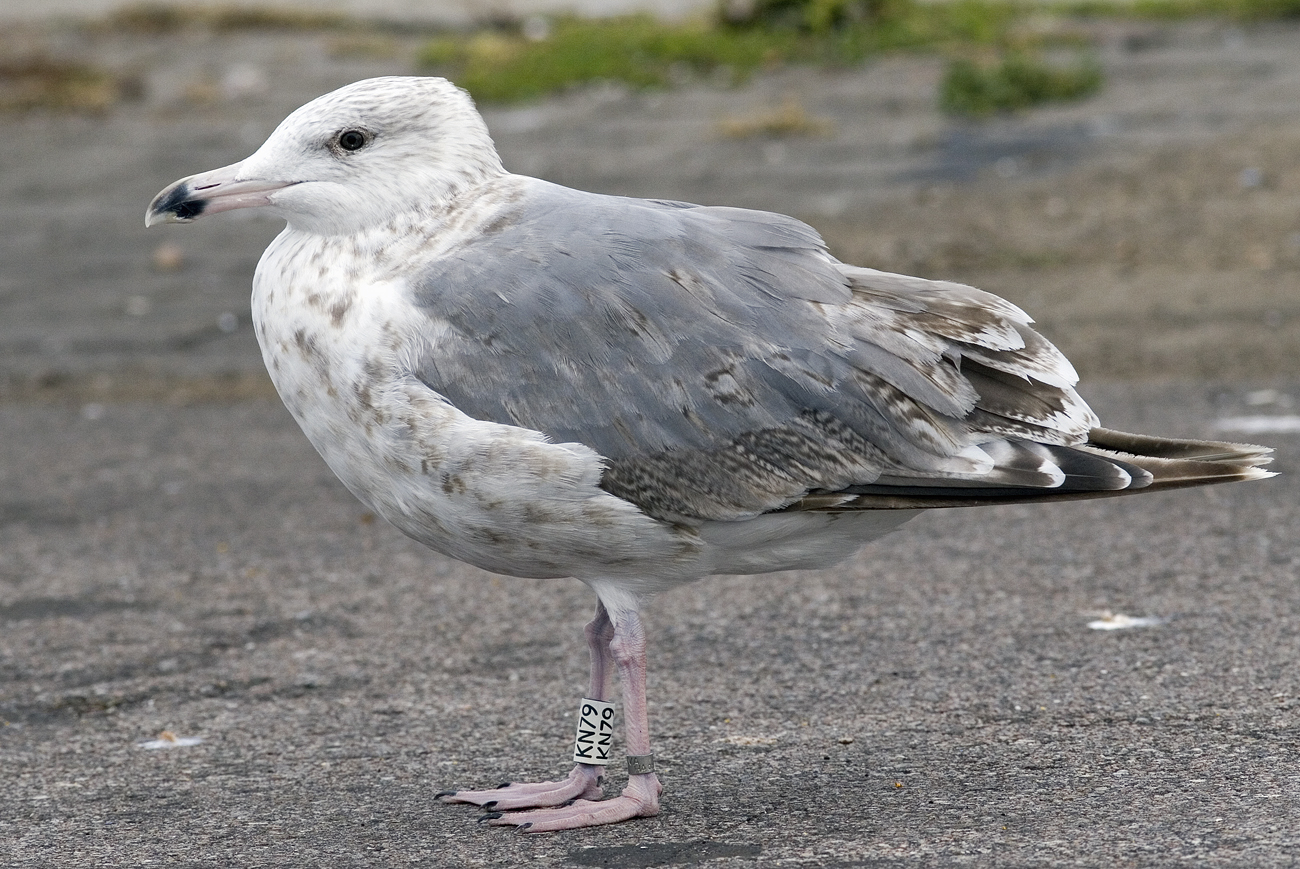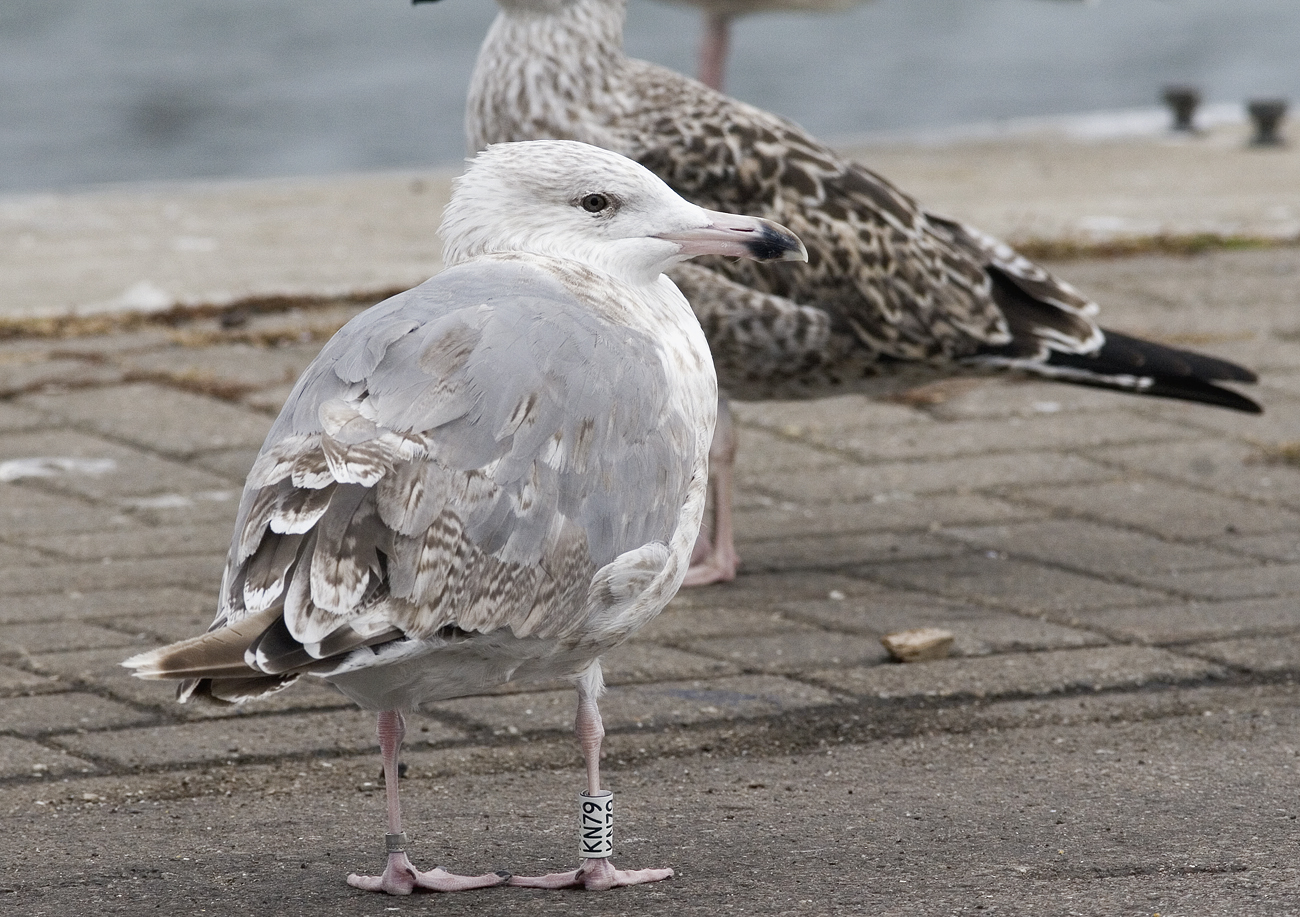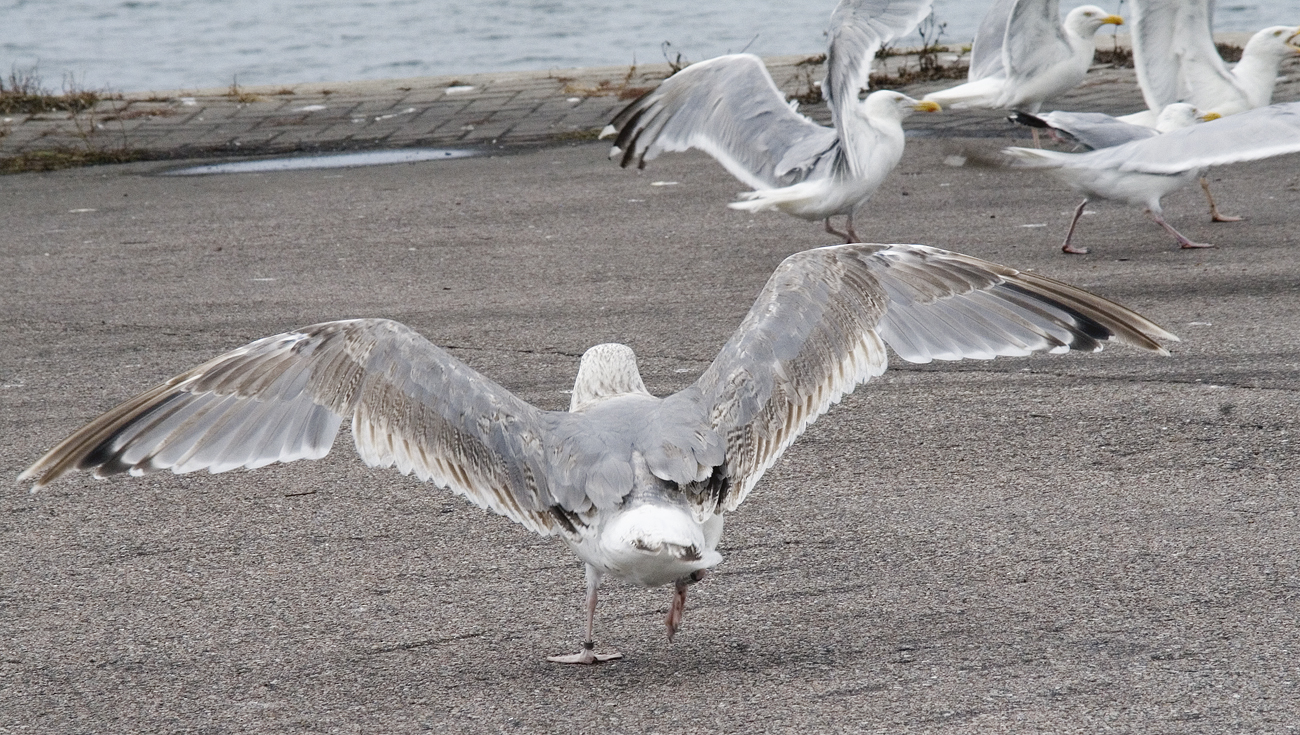 Herring Gull (argentatus & argenteus)
Herring Gull (argentatus & argenteus)
(last update: February 11, 2013)
Herring Gull (argentatus) KN79 3CY, August 12 2006, IJmuiden, the Netherlands.
3cy argentatus, from N Russia. Ring number is Moskwa HA-000 033, and a white darvic ring KN79. Ringed as pullus on 10 July 2004 in Russia, province Murmansk O: Kandalakshskiy Nature Reserve, Severnoe lesnichestvo, island Farvaternaya (67.05 N, 32.29 E). P9-P10 still old, P7 fully grown (but still falling short).
Recoveries:
1cy 2004 12 8 Ijmuiden strand NH NH NL 52.27 N 4.33 E A Duijnhouwer
1cy 2004 12 11 Ijmuiden strand NH NH NL 52.27 N 4.33 E V de Boer
2cy 2005 6 15 Ijmuiden forteiland NH NH NL 52.27 N 4.33 E F Cottaar
2cy 2005 8 10 Ijmuiden haven NH NH NL 52.27 N 4.33 E K en J Verbeek
2cy 2005 9 17 Ijmuiden haven NH NH NL 52.27 N 4.33 E K en J Verbeek
3cy 2006 3 4 Katwijk strand ZH ZH NL 52.12 N 4.27 E nn
3cy 2006 7 11 Ijmuiden haven NH NH NL 52.27 N 4.33 E nn
3cy 2006 8 11 Ijmuiden haven NH NH NL 52.27 N 4.33 E Roy Slaterus
3cy 2006 8 12 Ijmuiden haven NH NH NL 52.27 N 4.33 E M Muusse
3cy 2006 10 14 Ijmuiden haven NH NH NL 52.27 N 4.33 E M Muusse
4cy 2007 2 26 Ijmuiden haven NH NH NL 52.27 N 4.33 E nn
4cy 2007 3 2 Ijmuiden haven NH NH NL 52.27 N 4.33 E L Edelaar
4cy 2007 4 14 Ijmuiden haven NH NH NL 52.27 N 4.33 E K en J Verbeek
5cy 2008 1 28 Ijmuiden haven NH NH NL 52.27 N 4.33 E H Buckx

S1 fully grown, S2-S3 missing, S4 inwards old 2g. Central rectrices missing. Image below shows KN79 next to local grey argenteus.
From June to October, a complete moult
will bring 3cy argentatus in so-called "third winter"
plumage. By August, the first neat streaks can be found on the crown and
neck. After the complete moult is finished in autumn, the head will show
extensive 'winter streaking', often neat fine streaking in argentatus and mottled brown contrasting with the white breast as in an executioner's
hood in many argenteus. The scapulars and mantle are pale
adult-like grey, although some individuals may show an immature pale brown
hue or arrow-head patterns on the lower scapulars.
From June, 3cy argentatus are moulting new third generation plain
grey wing-coverts, starting with the outermost median coverts. Contrary
many argenteus, 3cy argentatus often show immature patterns
on the inner greater coverts, inner and outermost median coverts and upper
tertials (the first moulted wing-coverts and tertials in the complete
summer moult). When inner greater coverts and median coverts were included
in the partial autumn moult in 2cy, these feathers are left out of the
moult sequence in the very early moult-stage. By the end of the complete
moult (October), all wing-coverts have been replaced.
During the summer, the primaries are moulted to third generation. In argenteus, the first inner primaries are dropped by late May and the outer primary P10 will be dropped by late August. The primary moult is completed by late-October, in argenteus, when the new outer primary P10 is fully grown. Preliminary data from Tampere, Finland, indicate 3cy argentatus from this region are not delayed in primary moult compared to argenteus from continental NW Europe. The third generation primaries are clearly adult-like, with inner primaries P1-P3 plain grey with a white tip. The outer-wing shows a clear black triangle, extending on the greater primary coverts. From P4 outwards, the primaries show black sub-terminal markings. The white primary tips are obvious in the inner primaries, but are only poor developed on third generation P9 and P10. The third generation P10 normally shows a small white mirror (lacking in some birds). The new tail-feathers will be predominantly white, with clear immature black markings. The iris turns pale yellow in summer in most argenteus (July-August), but quite some argentatus will keep the iris amber to dark brown.
In the tables below, the primary moult scores of 3cy July argentatus in Finland can be read:
| Primary moult score of 3cy argentatus Herring Gull, at Tampere landfill, Finland (61.33N, 23.59E) on July 13 2003, 15:00 h. | |||||
| . | P4 fg | P5 fg | P6 fg | ? fg | n: |
P5-P10 |
- | - | - | 1 | 1 |
| P6-P10 | - | - | - | - | - |
| P7-P10 | 2 | 1 | - | 8 | 11 |
| P8-P10 | 1 | 40 | 3 | 25 | 69 |
| P9-P10 | - | 1 | 9 | - | 10 |
| n: | 3 | 42 | 12 | 34 | 91 |
| n
= 91; m old P = 3.0; SD old P = 0.58. Survey at Tampere, landfill, in resting group at 'Bio I'. |
|||||

The differences between typical
western argenteus from the U.K. and northern Scandinavian argentatus is rather straightforward on primary pattern P5-P10. However, there
is a gradient and overlap in features of birds from populations in
northern Germany, Denmark and southern Norway.
Identification is even more challenging in birds from Baltic
populations, which show both characteristics of argenteus and argentatus, but sometimes also of the southern taxa michahellis and particularly cachinnans.
Adult birds from the western populations argenteus show more
black in the outer primaries, compared to northern argentatus.
In argenteus, P5 normally shows small black sub-terminal
markings, concentrated on the outer-web as a clear-cut black angular
spot and in some birds extending on the inner-web as a diffuse
streak. There may be some black on P4 as well, although this might
be a clue for near-adult birds. In argentatus, especially
from far northern Scandinavia, the black marking on P5 is completely
lacking or is very limited and diffuse.
Argenteus often has a black sub-terminal band on the top of P10,
dividing the tip from the mirror. If the black sub-terminal band on
P10 is broken, there is often still black on the inner and
outer-web's edge of P10. Normally argentatus lacks
sub-terminal markings on the outer-web of P10.
Baltic argentatus often have the black marking on P5 confined to the outer-web as a single rectangular small black square, with well-defined borders (not diffuse as in most Finnmark birds). In most Baltic birds, the white tip of P10 fully merges with the mirror, without a single sign of a sub-terminal band. The greyish-white 'tongue' on the inner-web is often broad and continues far down P10, almost creating a thayeri pattern on P10. The shape of the division line between greyish tongue and black outer-web can be an identification clue: In cachinnans this division line often makes a strong angular curve and has a smooth straight line, unlike the pattern of Herring Gulls, which often show a "saw-blade" motive or otherwise much irregularities along the division line. Sometimes wear of the outer primaries may be useful as a first indication of origin: An early moulting species as cachinnans on average show more abrasion in the feathers than later moulting argentatus.
Extensive research on the P10 pattern of Scandinavian argentatus was done for Norwegian birds by the Norwegian ornithologist Edvard Barth, and is presented in the table below.| Table 4 from E.K. Barth, The circumpolar systematics of Larus argentatus and Larus fuscus with special reference to the Norwegian populations, 1968. 200 Norwegian birds. (Notation converted to what we use in the texts, MM). | ||||||||||||||||||||
| locality | sample size | tip pattern P10 | tip pattern P9 | colour of P10 inner-web | black present from P10 to: | |||||||||||||||
| 1 | 2 | 3 | 4 | 1 | 2 | 3 | 4 | 5 | 1 | 2 | 3 | 5 | 6 | P7 | P6 | P5 | P4 | |||
| East Finnmark | 15 | n | 10 | 1 | 2 | 2 | 5 | 4 | 1 | 1 | 4 | 5 | 7 | 3 | 12 | 3 | - | 10 | 5 | - |
| % | 67 | 7 | 13 | 13 | 33 | 27 | 7 | 7 | 27 | 33 | 47 | 20 | 80 | 20 | - | 67 | 33 | - | ||
| Tamsöy in Central Finnmark | 33 | n | 17 | 7 | 6 | 3 | 10 | 10 | 6 | 0 | 7 | 12 | 20 | 1 | 23 | 10 | - | 19 | 13 | 1 |
| % | 52 | 21 | 18 | 9 | 30 | 30 | 18 | - | 21 | 36 | 61 | 3 | 70 | 30 | - | 58 | 39 | - | ||
| Troms | 29 | n | 17 | 8 | 3 | 1 | 11 | 9 | 4 | 1 | 4 | 3 | 20 | 6 | 24 | 5 | - | 24 | 5 | - |
| % | 59 | 28 | 10 | 3 | 38 | 31 | 14 | 3 | 14 | 10 | 69 | 21 | 83 | 17 | - | 83 | 17 | - | ||
| Bodö and Röst | 32 | n | 15 | 10 | 3 | 2 | 19 | 3 | 5 | 0 | 3 | 3 | 24 | 5 | 27 | 5 | 1 | 18 | 13 | - |
| % | 50 | 33 | 10 | 7 | 63 | 10 | 17 | - | 10 | 9 | 75 | 16 | 84 | 16 | 3 | 56 | 41 | - | ||
| Tarva | 20 | n | 8 | 7 | 3 | 2 | 11 | 5 | 4 | 0 | 0 | 10 | 8 | 2 | 12 | 8 | 1 | 7 | 10 | 2 |
| % | 40 | 35 | 15 | 10 | 55 | 25 | 20 | - | - | 50 | 40 | 10 | 60 | 40 | 5 | 35 | 50 | 10 | ||
| Stavanger and Lindesnes | 42 | n | 18 | 13 | 4 | 6 | 23 | 12 | 3 | 2 | 2 | 15 | 23 | 4 | 37 | 5 | - | 13 | 29 | - |
| % | 44 | 32 | 10 | 14 | 55 | 28 | 7 | 5 | 5 | 36 | 55 | 9 | 88 | 12 | - | 31 | 69 | - | ||
| Oslo Fiord | 29 | n | 19 | 6 | 3 | 1 | 20 | 1 | 4 | 1 | 2 | 12 | 14 | 3 | 24 | 5 | - | 17 | 12 | - |
| % | 66 | 21 | 10 | 3 | 71 | 4 | 14 | 4 | 7 | 42 | 48 | 10 | 83 | 17 | - | 59 | 41 | - | ||
| . | ||||||||||||||||||||
| 1:
all white 2: trace of black near tip 3: incomplete black bar near tip 4: complete black bar or black tip |
1:
broad white band over both webs 2: white spot on both webs 3: white spot on inner web only 4: no white spot present 5: 'thayeri-pattern' |
1:
like mantle colour 2: slightly lighter than mantle colour 3: markedly lighter than mantle colour 5: relatively sharp border between black and grey 6: gradual transition from black to grey |
||||||||||||||||||
Especially birds from north Scandinavian Finnmark may show the characteristic 'thayeri' pattern in the outer primaries P9 and P10 (column 5 of tip pattern P9 in the table). This pattern is named after the Thayer's Gull, which often shows a particular pattern in the outer primaries: the mirror and the white tip merge and are connected to the pale inner-web (see this image). In other words: the black medial band of the outer-web doesn't fully reach the edge of the inner-web and there is no sub-terminal band. In Thayer's Gull this pattern may be very obvious and, together with the 'string of pearls' may be indicative for identification.


